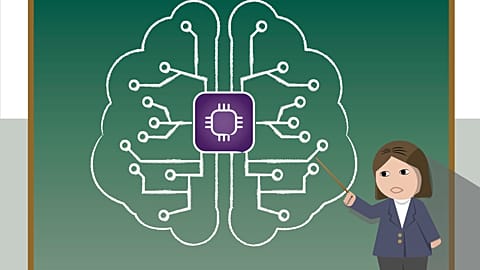Teachers in Europe are expected to continue striking for better pay and working conditions in 2024 after many of their salaries fell in real terms.
Teachers across Europe have gone on strike in recent years for better pay and working conditions, while many European education systems are suffering from shortages.
They plan to continue striking and taking to the streets to be heard in 2024 as living costs increase and real wages are down in many countries.
Several indicators suggest that the problem is serious. Annual starting salaries of teachers, which are adjusted for inflation, fell in many countries across Europe in the last six years.
More than half of teachers in the EU are not satisfied with their salaries. Only one-fifth of them think that the teaching profession is valued in society, and one in 10 regrets becoming a teacher.
Both 2022 and 2023 saw a series of teacher strikes take place across Europe including the UK, France, Germany, Italy, Hungary, Spain, Portugal, Czechia, and Romania.
The calls of unions show that strikes will continue in 2024.
Teachers in Northern Ireland have already confirmed that they will join industrial action after Christmas.
So, how do teacher salaries compare across Europe? Which countries pay teachers the most and the least? How much have teacher salaries changed in real terms in recent years?
Average gross teachers salaries
Teacher salaries vary widely across Europe according to the European Commission EACEA/Eurydice’s 'Teachers’ and school heads’ salaries and allowances in Europe in 2021/2022' report.
The average annual gross actual salaries of low secondary teachers (ISCED 2) in public schools ranged from around €8,160 in Bosnia and Herzegovina to €71,184 in Germany.
Data for some countries, including Luxembourg, which ranked at the top in the previous year, is not available for 2022.
The average actual salary refers to the weighted average gross annual salary, including the statutory salary and other additional payments such as bonuses and allowances.
It excludes the employers’ social security and pension contributions but includes those paid by the employees.
While we look at low secondary teachers in analysis, the graph below also shows the salaries of other education levels such as pre-primary (ISCED 02), primary (ISCED 1) and upper secondary (ISCED 34) teachers.
The annual actual salary was over €50,000 in eight countries including the Netherlands (€67,638), Denmark (€66,673), Ireland (€63,278), Austria (€60,686), Norway (€59,276) and Finland (€52,076).
Teachers in France earned €30,000 less than their colleagues in Germany
The annual actual salary in Italy was less than half the German figure. Teachers in France also earned almost €30,000 less than what their colleagues in Germany received in 2021/2022.
The salary of teachers was below €20,000 in five EU members such as Greece (€18,765), Poland (€16,725) and Romania (€12,987).
Teachers in Nordic countries are comparatively paid well, whereas the actual salaries of teachers are the lowest in EU member candidates in the Balkans.
According to the UK government's website, classroom teachers were paid an average of €45,734 (£38,982) in the 2021/2022 school year in England, €45,765 (£39,009) in Wales and €46,959 (£40,026) in Scotland.
However, it should be noted that UK figures are not directly comparable with Eurydice’s European figures.
Wide disparities in salaries in purchasing power standard
Salaries in purchasing power standard (PPS) can provide a fairer comparison across all countries.
PPS is "an artificial currency unit" defined by Eurostat, where one PPS unit can theoretically buy the same amount of goods and services in each country.
Looking at teacher salaries in PPS, there are still wide disparities across Europe.
Germany (56,621 PPS) recorded the highest annual gross statutory starting salaries of lower secondary teachers in PPS.
This figure was more than four times that in several countries including Albania (12,531 PPS), which was the lowest amount in 2021/2022, and Hungary (12,852 PPS).
At the top, Germany was followed by Luxembourg (52,963 PPS) and Switzerland (46,722 PPS).
Teacher salaries were below 20,000 PPS in thirteen countries, among which eight were EU members: Estonia, Romania, Bulgaria, Greece, Poland, Slovakia, Latvia, and Hungary, respectively.
Turkey was ranked the fourth in PPS among 35 countries, which came in at eleventh place in 2020/2021.
Besides Turkey, EU candidate countries Montenegro, North Macedonia, and Serbia had higher figures in PPS than several EU countries.
Actual salaries higher than the GDP per capita in 11 EU countries
Annual gross actual salaries of lower secondary teachers were higher than the gross domestic product (GDP) per capita in 11 EU countries whereas it was lower in 10 EU member states in 2021/2022.
This suggests that teachers who start working in state schools can earn significantly less than the average GDP per capita in most European countries.
The ratio of annual gross actual salaries of teachers to GDP per capita ranged from 0.59 in Norway to 1.62 in Cyprus.
While Germany is one of the countries with the highest GDP per capita in Europe, the ratio is 1.54, meaning that junior teachers still earn more than the average GDP per capita.
This ratio was just 1.22 in France.
Salaries down in real terms in several countries
Teacher salaries have fallen in real terms, meaning inflation is taken into consideration, in several countries in the last six years. In nine countries, the annual starting salaries of teachers (adjusted for inflation) decreased for all education levels between 2014/2015 and 2021/2022.
Lower secondary teacher salaries fell in ten countries: Norway (–15.4 per cent), Greece (–10.1 per cent), Portugal (–9.2 per cent), Cyprus (–8.1 per cent), Italy (–8 per cent), Belgium (–7.7 per cent), Finland (–5.1 per cent), Turkey (–3.5 per cent), the Netherlands (–2.7 per cent) and Spain (–2.3 per cent).
The salaries significantly increased in Bulgaria (116.1 per cent) in this period. The increase was also above 40 per cent in Latvia, Serbia, and Lithuania.
In Germany and France, salaries rose less than 3 per cent.
According to the Institute for Fiscal Studies, teachers’ salaries in England decreased by an average of 11 per cent between 2010 and 2022.
Are teachers satisfied with their salaries?
No, they are definitely not.
According to the OECD’s Teaching and Learning International Survey (TALIS) in 2018, half of teachers (52 per cent) who were under 30 years old were satisfied in the EU (average of 23 countries), while this rate was just 34 per cent for teachers above 50.
The satisfaction rate in the older age group was evidently low in most of countries. For example, it was below 27 per cent in 12 of 21 countries, including Sweden and France.
Some regrets about deciding to become a teacher
The survey also demonstrates that teachers are not happy with the perceptions of society. In the EU-23, only 18 per cent think that the teaching profession is valued in society. This rate is below 20 per cent in 16 of 22 countries such France (7 per cent), Sweden (11 per cent) and Denmark (18 per cent).
Almost one in ten in the EU-23 also regret that they decided to become a teacher. This rate is above the EU average in Sweden (12 per cent), and Portugal (22 per cent).
Shortage of teachers and other concerns for the future
While many European countries have been suffering from a lack of qualified teachers for decades, new teaching eco-systems introduced by COVID-19, and the integration of Ukrainian children into EU schools due to Russia’s invasion of Ukraine, are likely to have contributed to exacerbating this problem, according to the European Commission’s 'Indicators for monitoring teacher shortage in the European Union: possibilities and constraints' report.
The lack of attractiveness of the teacher profession is often identified as a main factor driving teacher shortage.
"Low pay, job insecurity, and high workload make it difficult to attract and retain qualified teachers," the report found.
According to Eurydice’s 'Teachers in Europe Careers, Development and Well-being' report, 35 countries across Europe face teacher shortages.
There are only three countries where oversupply is the main challenge, namely Cyprus, the United Kingdom (Northern Ireland), and Turkey.


















